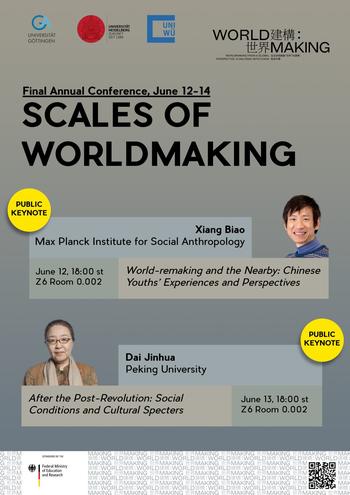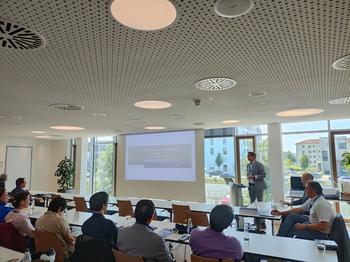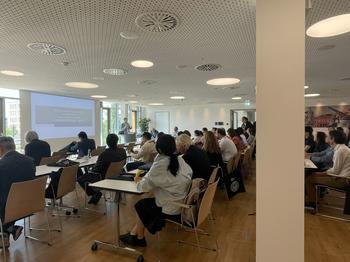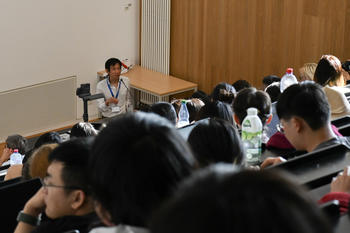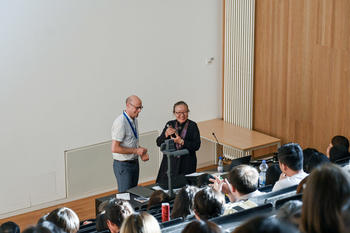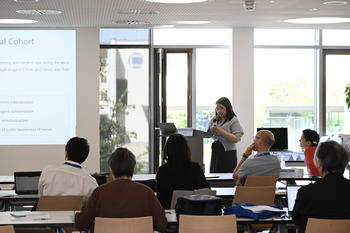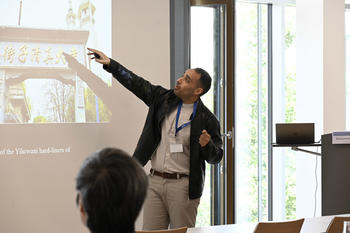Report of the Joint Center's Annual Conference 2025
Worldmaking Annual Conference - Poster
A Welcome Speech by Roland Altenburger opened the conference...
...which was attended by around sixty participants at Skyline Hill Center.
Keynote Speeches by Xiang Biao...
...and Dai Jinhua were held before public audiences.
A total of twenty four presenters...
...provided engaging talks over three conference days.
News from Oct 07, 2025
Between June 12 and 14, the final annual conference of the Joint Center for Advanced Studies “Worldmaking from a Global Perspective: A Dialogue with China” was held at Würzburg University.
Report:
The final annual conference of the Joint Center brought together scholarly teams from Georg-August-Universität Göttingen, Ruprecht-Karls-Universität Heidelberg, and Julius-Maximilians-Universität Würzburg, as well as current and former visiting fellows to the projects. In addition, an open Call for Papers drew a large number of applications, and several external guests were invited after their proposals had been accepted. A total of twenty-four presentations were held at the main conference venue, the Skyline Hill Center, over the three conference days. Around sixty people attended, ensuring lively discussions and rich academic exchanges. In addition, the two keynotes by Xiang Biao and Dai Jinhua were open to the public and both attracted sizable crowds, filling the university’s lecture hall.
The conference featured the theme “Scales of Worldmaking”. Worldmaking designates the process through which actors create a specific, comprehensible notion of a totality—world. This totality is both part of concrete, lived reality and a product of their specific imagination. It becomes tangible both physically and socially but also mentally and in a metaphorical sense. Worldmaking can thus take different forms and be realized through various types of action, it can take different types of material form, and it occurs on different scales – from the local and regional to the global and planetary. These are highlighted in this conference, as they can be brought to light using different disciplinary perspectives (in particular, but not limited to those of anthropology and sociology) focusing on interactions between these different scales of worldmaking. Due to this wide and inclusive theme, a broad and interdisciplinary range of presentations could be accommodated, which covered both historical as well as contemporary perspectives on China and connected scholars beyond their immediate disciplines and academic social worlds.
The conference started on Thursday with welcome speeches by the Dean of Studies of the Faculty of Arts of Würzburg University, Roland Altenburger, and by the Head of the Joint Center Worldmaking, Björn Alpermann. The first and only panel for the opening day was chaired by Dominic Sachsenmaier from the University of Göttingen and covered the themes of historical demographic developments, ethnic relations and transnational interconnectivity. In the opening presentation, Chong Myong Im (Chonnam National University) analyzed Chinese-ethnic Identities in Cold-War South Korea. Edward Wang (Rowan University) then presented on the global history of the sweet potato and its impact on Chinese population growth. Sally Chengji Xing (Nankai University) followed with a talk titled “American Influence and the China Foundation as a Sponsor of Chinese Science” before Björn Alpermann (University of Würzburg) presented on Bingtuan Expansion in South Xinjiang and its implications for ethnic relations, which concluded the opening session.
The well-attended public evening keynote by renowned anthropologist and director of the Max Planck Institute for Social Anthropology, Xiang Biao, was titled World-remaking and the Nearby: Chinese Youths’ Experiences and Perspectives, dissecting the perspectives of today’s younger generations both in China and beyond. It was an encouraging sight that this lecture drew a large crowd, with several people having traveled from afar. For conference participants, the evening then concluded with a dinner at restaurant Bürgerspital.
The second conference day began with a morning panel chaired by Sara Landa and focusing on developments and social worlds in contemporary Chinese cities. First, Ryanne Flock (Würzburg University) provided a critical analysis of statistical urban housing data in China’s population censuses. Isabel Heger-Laube (Free University Berlin) took a closer look at narratives surrounding state-led urbanization, based on ethnographic fieldwork in Huaming model town in Tianjin. Michael Malzer (Würzburg University) then presented on forms of image-building and processes of Sinicization in the Northwestern city of Yinchuan, Ningxia. In the last talk of the panel, Hannah Klepeis (University of Vienna) focused on how tourism, development and ethnic policies are affecting Shangri-La and the Tibetan borderland.
The following panel, chaired by Björn Alpermann, stayed within the realms of Chinese urbanity and focused on environmental issues and animals. First, Lu Qianyu (Cambridge University) looked at processes of green development and urban regeneration following the Shanghai Expo of 2010. Tan Xiaohong (Kassel University) followed with a presentation of the social world of urban gardening in a Chinese city. Sara Landa (Heidelberg University) then focused on interactions between non-humans and humans in literary cityscapes. Concluding the panel, Winnie Yee (University of Hong Kong) asked the question “Where Are the Animals in Chinese Urban Texts” and provided various examples of the animal gaze in Chinese literature and films.
After a lunch break, the third panel of the day (chaired by Harlan Chambers) continued with the theme on animals: First, Matthias Schumann (Heidelberg University) introduced a more historical scope by analyzing the regulation of dogs in early twentieth-century Shanghai. Going back to contemporary China, Long Qilin (Shanghai Jiaotong University) discussed the social heterotopia narrative in ecological literature, while Huang Dingru (Tufts University) presented the trope of disappearance through cinematic animals. The final presenter of the session, Shi Xuefei (Chr. Michelsen Institute) then shifted the focus to the aquatic sphere with a presentation on Imaginations of Life in the Anthropocenic Mare Sinarum.
What then followed was the second evening keynote of the conference, given by well-known Peking University professor and cultural critic Dai Jinhua. It was titled After the Post-Revolution: Social Conditions and Cultural Specters and presented through the lens of Chinese films and television series of the last decades. The lecture, which was held in Chinese, again attracted a great number of interested scholars and students. After the keynote, a dinner at Chinese restaurant Mainkuh – a boat on the river Main – concluded the long day for the participants.
The conference continued on Saturday with a morning panel, chaired by Ryanne Flock, which saw presentations covering more historical aspects of worldmaking: first, Philipp Grimberg (University of Erlangen-Nürnberg) gave a talk on collecting and antiquarianism in late imperial China. Then, Harlan Chambers (Göttingen University) moved to Republican times with a presentation on Fascism and its Critique in China’s Revolutionary Project. The next two talks were on Chinese Islam: Mohammed Alsudairi (Australian National University) analyzed how the Chinese government in the People’s Republic used sectarianism to govern Chinese Muslims. Janice Jeong (Simon Frazer University) concluded the panel with a talk on Chinese Muslim mobilities and their pilgrimages to Mecca.
The final panel of the conference, chaired by Matthias Schumann, brought the discussion back to the contemporary period. First, Li Dong (Chongqing Normal University) presented her ethnographic work on drug dealing and the Chinese heroin generation. Then, Gil Hizi (University of Frankfurt) focused on Chinese village basketball in Guizhou, a phenomenon known as “CunBA”. Lin Lefeng (Xi'an Jiaotong Liverpool University) then provided an ethnographic account of the social worlds of a night food market. Finally, Liu Kang (Duke University) took a step back from the micro- to the macro level and gave the final presentation of the conference, titled Culture vs Civilization Debates in China in Recent Years. After the final panel, the conference came to an end over lunch, having provided a stimulating three days of discussions and exchange.

